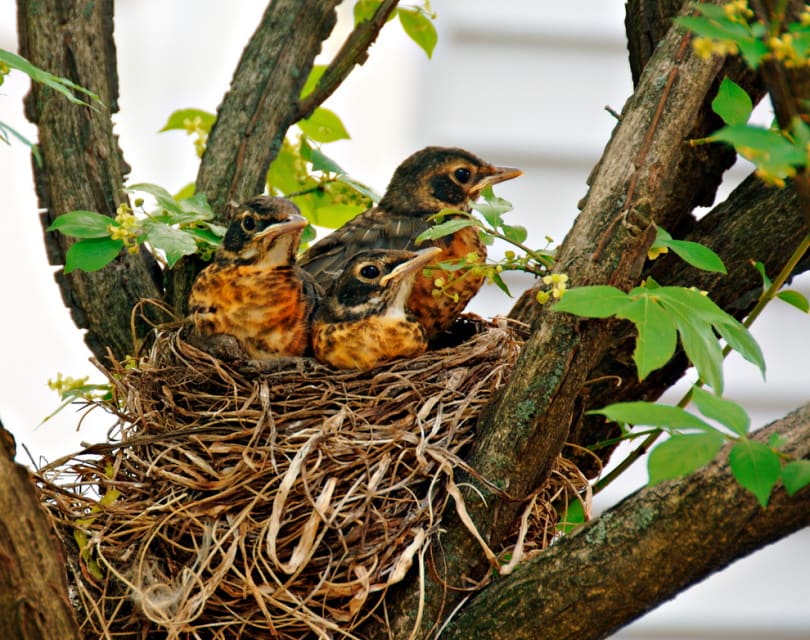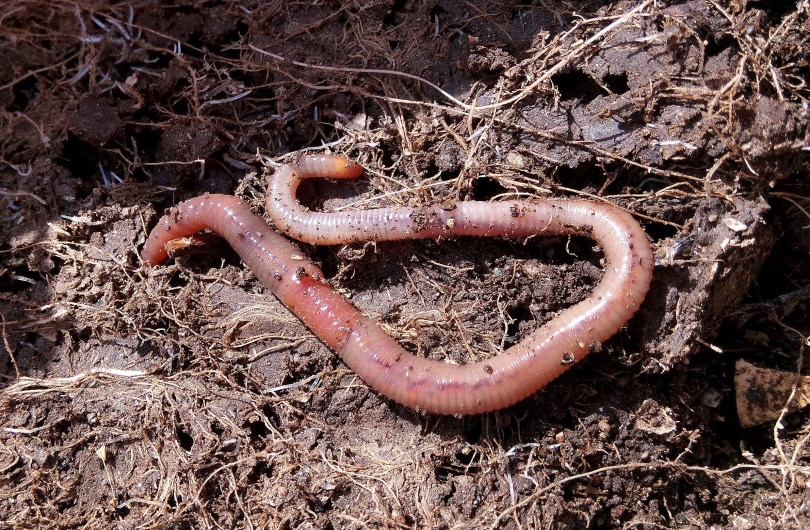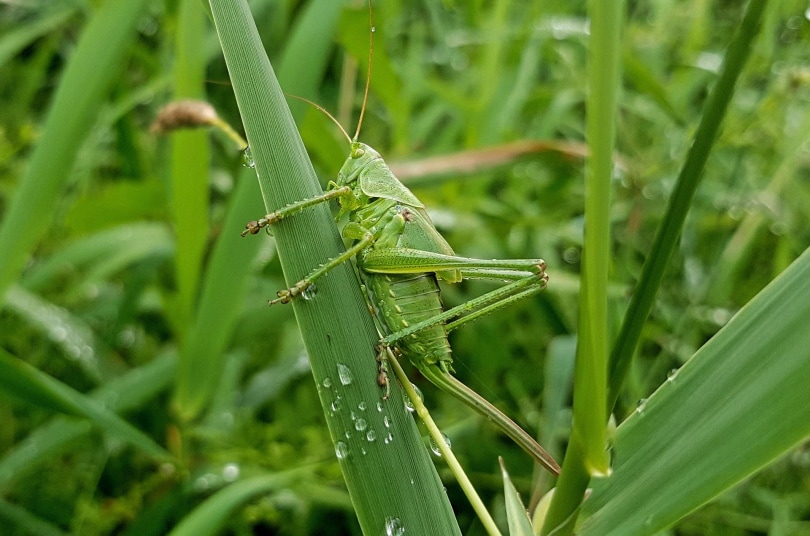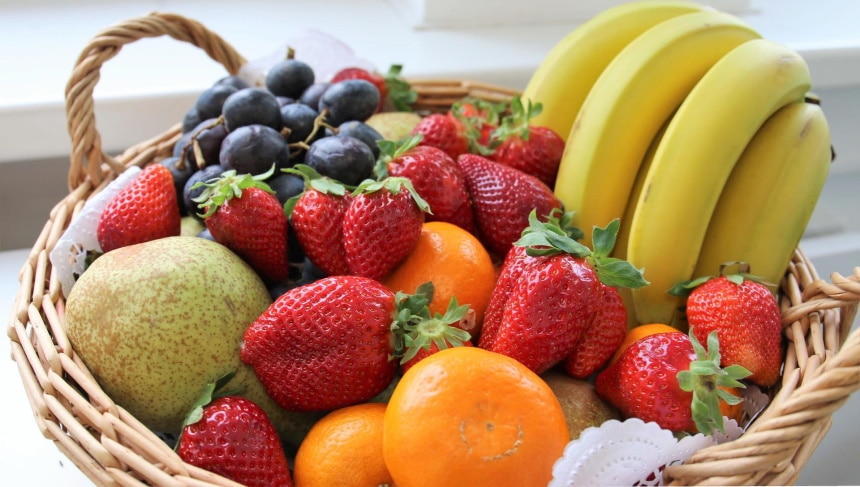What Do Baby Robins Eat? 8 Typical Foods
Last Updated on

If you’ve found a nest of baby robins and the mother doesn’t seem to be returning—what next? Should you wait for the mother to come back? Should you leave the chicks? Or could you possibly foster them a new home until they grow up? Well, there’s a lot to discuss here, and the most important thing you should know while caring for a baby robin is their diet. Even if you’re observing the family from a distance and want to know what makes them grow, we’ve got the information. We’ve put together eight typical foods that these adorable critters feed on; read more to see what they love!

Before You Start
There are a few very crucial points that you need to know before fostering a baby robin. Firstly, you’ll want to check your state’s laws to see whether or not raising a wild animal is legal. Second, in most cases, you should leave wild animals alone for nature to continue its process. Lastly, if you have the okay to foster baby chicks, consider a few of these details, so you and the bird are safe.
- Be sure not to touch or get too close to baby robins, as doing so may prevent the mother from returning
- Wear gloves and other safety equipment to prevent the spread of disease
- Don’t release the bird into the wild but take them to a local conservation organization to see if they can continue care
Top 8 Foods Baby Robins Eat:
1. Earthworms

The most common food a mother robin gives to her young is earthworms—also known as night crawlers. They live in soil-rich grounds and provide a great deal of nutrition. If you are raising the birds yourself, night crawlers found in fishing supply shops and some convenience stores are a perfect choice. It’s best to feed them live; they can be stored in a refrigerator to last longer. Bonus tip: You can collect these worms in your backyard if you do a bit of digging. Check underneath rocks, logs, or gardens for the best results.
- Can be found naturally
- It’s their primary food in the wild
- Cheap
- Requires refrigeration to preserve freshness
2. Mealworms

Similar to earthworms, mealworms are food that adult robins give to their babies in the wild, and you can’t go wrong with them. They are sold in pet supply stores for birds or reptiles. They provide loads of protein for the chicks to grow fast and are easy to administer.
Additionally, mealworms can be found under natural objects and debris during warmer months. One thing to note is that mealworms can transform into beetles after a certain time. They don’t need to be put in the fridge, but you should always keep them cool.
- Easily available
- Cheap
- Healthy source of natural protein
- They turn into beetles which are harder to store
3. Beetles

Beetles are an everyday insect found in your backyard and are a plentiful source of food for baby robins to eat. We recommend using a small bug container and searching your garden, lawn, or backyard for leafy plants and trees. There are copious beetle species, but you should focus on feeding baby robins the smaller beetles so they can digest them easily. Otherwise, they may choke due to the size. Make sure your robin is old enough to consume them since newly born chicks won’t have the strength to swallow them. After two weeks, they will be safe to eat for sure.
- Found in your backyard
- Natural source of food
- Not found in stores
- Aren’t a good option for newborns
4. Crickets

Collecting crickets shouldn’t be difficult because they inhabit several landscapes during warmer weather. This makes them a consistent source of food for your robins. Luckily, they are also available in most pet retail stores for lizards. You can get them in a bag, but it’s better to bring your own container, so they don’t suffocate after being left in the bag. If you don’t have one, you can poke a hole in the bag or open it up often. They are very cheap and come in different sizes. Small crickets are the best option since they will be a better fit for a baby bird. The only downside is that they jump around a lot. This makes it a chore to feed them directly since they will jump away if they have the chance.
- Found domestically and in stores
- Difficult to feed
- It could be hard to find small crickets where you live
- They die out fast even when stored in containers
5. Grasshoppers

An alternative to crickets is grasshoppers. We all know how jumpy these wild insects are, and they might be the most challenging to gather on our list. Because of this, they aren’t as good of an option compared to the others we’ve mentioned. Adult birds can hunt them much better than humans, and you might have to use a bug net to increase your chances of catching them. On the other hand, they are a great source of natural food. Just keep in mind that some hoppers are too large for baby robins. Also, in the wild, adult robins partially digest them and then feed them to their young. You might need to imitate this by splitting them into smaller pieces. Generally, grasshoppers are better suited for young robins that have grown substantially.
- Found everywhere outside
- A healthy part of a robin’s diet
- Hard to catch
- Difficult to feed
- Can be too big for baby robins
6. Caterpillars

Another wild bug that baby robins love is the caterpillar. These soft, wormy insects are a perfect way to feed your birds as they can be digested easily and are found in their natural habitat. Like mealworms, all caterpillars transform into winged creatures. They become moths or butterflies, which are much more difficult to feed and are not recommended.
- Their soft bodies make them easy for robins to eat
- Found outdoors in most robin habitats
- They create a cocoon to transform
- Not found in stores
7. Berries and Fruits

Although we’ve mostly covered insects and carnivorous foods so far, berries are an exceptional source of food for baby robins. You can give your little birds several fruits or berries, such as blackberries, blueberries, strawberries, grapes, bananas (small pieces), apples (small pieces), and many more. Compared to a meaty diet, these will still provide the adequate nutrition they need. Another huge benefit is that bugs are non-existent in the wintertime. Robins are known to live year-round in snow-covered environments, and fruit is a great alternative.
- Found in all grocery stores
- A great option for winter
- Easy to feed
- Cheap
- Not as dense of protein content
8. Waxworms

Last but not least is the waxworm, which is a common insect found at every Walmart or big retailer. You shouldn’t have too much trouble finding them, and they are quite similar to mealworms. However, there are many of us out who would rather not deal with them since they resemble maggots. They aren’t a bad choice in terms of their nutritional value, though. They’re relatively cheap as well!
- Cheap
- Available at large retail and convenience chains
- Easy to feed
- They look like maggots!

Conclusion
If you’re here because you’ve found a helpless baby robin on your front lawn, you must know which foods to give to your newly fostered bird. Naturally, these birds are omnivorous and need an adequate source of protein and vitamins to grow strong and healthy. After your robins have grown, it’s a good idea to contact a local animal conservation district to find a permanent home. These eight foods should reassure you that you’re feeding them what they need. Good luck with your baby robins!
Featured Image Credit: Jill Battaglia, Shutterstock
About the Author Robert Sparks
Robert’s obsession with all things optical started early in life, when his optician father would bring home prototypes for Robert to play with. Nowadays, Robert is dedicated to helping others find the right optics for their needs. His hobbies include astronomy, astrophysics, and model building. Originally from Newark, NJ, he resides in Santa Fe, New Mexico, where the nighttime skies are filled with glittering stars.
Related Articles:
10 Types of Hummingbirds in Arkansas (With Pictures)
8 Types of Hummingbirds in Nebraska (With Pictures)
5 Types of Hummingbirds in Idaho (With Pictures)
3 Types of Hummingbirds in Mississippi (With Pictures)
8 Types of Hummingbirds in Kansas (With Pictures)
5 Types of Hummingbirds in West Virginia (With Pictures)
5 Types of Hummingbirds in Ohio (With Pictures)
Where Do Nuthatches Nest? Nuthatch Nesting Habits Explained
